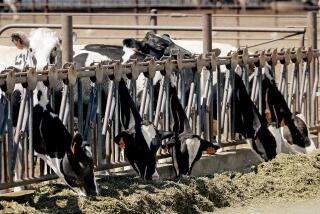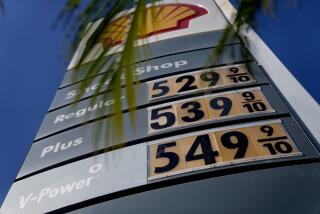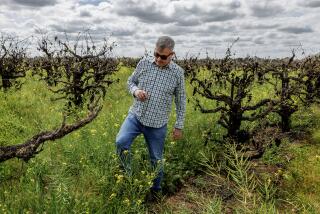State Grape Prices Juiced by Weather
Mother Nature may yet end Californiaâs wine glut.
The weather last year reduced the stateâs autumn grape crush 11% from 2002, making it the slimmest harvest since 1999. And now some prices are starting to tick up.
The closely watched California Agricultural Statistic Service report released Tuesday offered the freshest evidence yet that the three-year long price slump might be coming to an end. The report said that Kern County Cabernet Sauvignon grapes had been fetching $125 a ton, 31% more than in 2002, in part because of heavy demand for bargain wines such as the $1.99 Charles Shaw brand sold by the Trader Joeâs grocery chain.
Wine-grape brokers said other varieties were faring well, too. Joseph Ciatti of San Rafael, who also buys and sells bulk wine, said prices for many San Joaquin Valley grapes, from Muscat to Merlot to the grapes used for the ubiquitous White Zinfandel, could double by the 2004 harvest.
In the Central Valley, wineries are seeking out sources of grapes earlier than they did last year. âAs the Valley climbs out of the dungeon, the rest of the state is going to get better too,â said Nat DiBuduo, president of Allied Grape Growers, the stateâs largest grape cooperative.
Statewide last year, wine and juice processors crushed just under 3.4 million tons of wine, raisin and table grapes, according to Tuesdayâs report.
A cold wet spring followed by hot spells -- and the removal of 50,000 acres of vines, mostly in the Central Valley -- contributed to the smaller harvest.
That wasnât good news for all the players in Californiaâs $14-billion wine industry. Some growers were left with fewer grapes to sell, and not necessarily at higher prices.
âIt was a rough year,â said Nick Frey, executive director of the Sonoma County Grape Growers Assn. âOur tonnage was down 13% and our prices fell 6% and that means our growers got only $310 million in revenue last year, down $66 million.â
Statewide, red wine grapes brought an average of $600 a ton, down about 2% from 2002 and the lowest price since 1995. White wine grapes fell 3% to $418 last year, the lowest since 1995.
In 2003, the Chardonnay grape was again the most popular. Nearly 561,000 tons of Chardonnay were crushed last year, about 6% less than in 2002. Cabernet was second at 396,000 tons, up 4% from a year earlier. And as in previous years, Napa Valleyâs Cabernet Sauvignon was the gold standard, selling for $4,012 a ton, down only slightly from $4,021 in 2002.
The average price for all Napa grapes rose 3% to $3,033.
Prices in Californiaâs most famous wine region are helped by a quirk in the way grapes are sold there. Unlike the Central Valley, much of Napa Valley production is tied up in long-term contracts, which are linked to the previous yearâs prices. That means growers are protected when prices fall and wineries are protected when prices rise.
Napa Valley Cabernet prices âare out of whackâ compared with the overall market, said Ciatti, the San Rafael broker. He said that the small percentage of Napa Valley Cabernet grapes that werenât locked up under contract sold for $1,500 to $2,000 a ton on the spot market. Despite the generally upbeat reaction by much of the wine industry to news of a smaller harvest, there remain warning signs that prices have not stabilized. Whatâs more, he said, there still is an oversupply of Cabernet Sauvignon.
Rich Cartiere of the Wine Market Report newsletter pointed out that wine grape production in the Central Coast areas of Monterey, San Luis Obispo and Santa Barbara counties continued last year to climb at double digit rates.
âThere are areas ... where there are more new vineyards coming into production than people thought,â said Cartiere. âThat means the oversupply is going to continue, most particularly for Cabernet and Pinot Noir, for another two years.â
More to Read
Inside the business of entertainment
The Wide Shot brings you news, analysis and insights on everything from streaming wars to production â and what it all means for the future.
You may occasionally receive promotional content from the Los Angeles Times.











